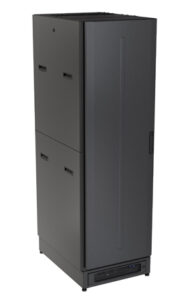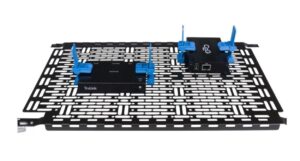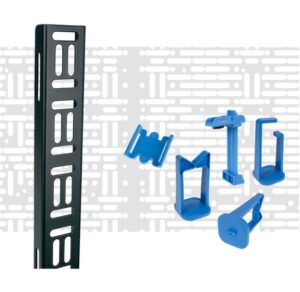As the Pro AV industry continues to evolve, it is crucial for professionals, especially those new to the field, to understand the significance of selecting quality rack products for their AV rooms. A well-designed and organized rack system not only improves the overall performance of the AV setup but also enhances ease of installation and promotes efficient organization. When I first came into the industry, I was a little overwhelmed by racks, and really did not take the time to understand them. Hopefully, this will take a little of the mystery out of them. In this blog, we are going to do a shallow dive into the world of racks. Hang onto your hats, it’s going to be a wild ride. (Not really, I just always wanted to say that.)
 Rack systems play a crucial role in the Pro AV space, providing a structured and organized framework for housing audio visual equipment. These systems are essential for ensuring proper installation, organization, and maintenance of AV gear. When selecting rack products, there are several key factors to consider optimizing performance and efficiency. Investing in high-quality rack products is essential to maintain the integrity of your audio-visual equipment. With their sturdy construction and robust materials, these racks can withstand the rigors of daily use, safeguarding your valuable AV gear and reducing the risk of equipment failures or damage. The idea here is to organize and protect your AV equipment, which is worth thousands of dollars, so don’t always look for the least expensive option.
Rack systems play a crucial role in the Pro AV space, providing a structured and organized framework for housing audio visual equipment. These systems are essential for ensuring proper installation, organization, and maintenance of AV gear. When selecting rack products, there are several key factors to consider optimizing performance and efficiency. Investing in high-quality rack products is essential to maintain the integrity of your audio-visual equipment. With their sturdy construction and robust materials, these racks can withstand the rigors of daily use, safeguarding your valuable AV gear and reducing the risk of equipment failures or damage. The idea here is to organize and protect your AV equipment, which is worth thousands of dollars, so don’t always look for the least expensive option.
First things first: The rack’s rail width, horizontal and vertical spacing of holes, and other measurements are standardized, so no matter which brand you choose, they will always be 19 inches wide. When we talk about racks, they are measured in something called a “RU.” What is an RU, quite simply it stands for “rack unit” which is equal to 1.75 inches. Racks are often recommended or designed based on the number of RU that you need to fit your equipment. The rack unit standard is essential to the data center and IT infrastructure industries. Data center managers can invest in racks and cabinets with the assurance that any manufacturer’s rack-mountable equipment will be measured by the same standardized height metric, RU. Additionally, the equipment’s mounting holes will always align with the holes in the server rack.
There are three basic types of racks available:
- Open Frame Racks: Just as they say, an open frame with mounting rails, but no sides or doors.
- Rack Enclosures: These have removable front and rear doors. These are typically used for heavier equipment, hotter equipment, and overall higher wattages. The front and rear doors are typically ventilated to allow proper air flow from front to back.
- Wall-Mount Racks: These are used when space is a concern, often coming in smaller form factors when a full floor rack is not needed.
One important consideration is cable management. A well-designed rack system provides ample space and options for managing cables effectively. Look for features such as cable management bars, cable trays, or built-in cable channels that allow you to route and secure cables neatly. This not only improves the aesthetics of your rack, but also minimizes the risk of signal interference and simplifies troubleshooting and maintenance tasks. Maintaining a neat and organized AV room is crucial for quick troubleshooting, system maintenance, and overall efficiency. Think for a moment about if something goes wrong and a tech needs to get in and quickly troubleshoot. If your cables are going in every direction and things are not organized correctly, the tech will have to spend valuable time just getting to the proper connections. Invest in the time up front, it will make things much easier when things go down – and they always do!
 Another critical aspect is ventilation. Adequate airflow is essential to prevent equipment overheating, which can lead to performance issues and even equipment failure. Look for rack products with proper ventilation options such as vented rack shelves, perforated doors, or integrated cooling fans. These features facilitate the movement of cool air and help dissipate heat generated by the AV equipment, ensuring optimal performance, and prolonging the lifespan of your gear. Would you like to be stuck in a room with loads of running electrical equipment and no air flow to cool it down? This sounds like the worst sauna in the world. Now, imagine what poorly ventilated racks can do to your valuable AV equipment. Not a pretty thought!
Another critical aspect is ventilation. Adequate airflow is essential to prevent equipment overheating, which can lead to performance issues and even equipment failure. Look for rack products with proper ventilation options such as vented rack shelves, perforated doors, or integrated cooling fans. These features facilitate the movement of cool air and help dissipate heat generated by the AV equipment, ensuring optimal performance, and prolonging the lifespan of your gear. Would you like to be stuck in a room with loads of running electrical equipment and no air flow to cool it down? This sounds like the worst sauna in the world. Now, imagine what poorly ventilated racks can do to your valuable AV equipment. Not a pretty thought!
Proper load distribution is also essential when loading a rack. Pay attention to weight limits specified by the rack manufacturer and distribute the weight evenly across the rack. Start by placing heavier equipment at the bottom of the rack and proceed upwards with lighter components. This helps maintain stability and prevents the rack from toppling over. Additionally, consider using rack shelves, panels, and drawers to organize and support equipment securely. I cannot stress enough how important it is to plan your rack layout beforehand. If you go in with a plan, then things will come together and work much more efficiently than just throwing pieces of equipment in randomly. Like the old saying goes, “Failing to prepare is preparing to fail.”
Additionally, consider the rack’s flexibility and expandability. Look for adjustable rack rails that can accommodate various equipment sizes and allow for easy installation and reconfiguration. This feature ensures compatibility with current and future AV equipment needs, allowing for scalability and adaptability as technology evolves. Do your research upfront. Know which products can be expanded to ensure they are “future-proof.” Do not fall for a gimmicky sale or closeout promotion. You want your equipment safe and organized in a manner that will withstand changes in your AV needs!
Don’t forget the power! When designing your rack layout, you need to remember you will need power for all your equipment. There are several options, but when building your rack, a reliable power source with quality surge protection is a must have. There are several assorted styles available. These can be mounted horizontally or vertically inside the rack, whichever fits best into your design.
 Lastly, consider the overall build quality and durability of the rack products. Look for racks made from sturdy materials like steel or aluminum that can withstand the weight of equipment and provide long-lasting reliability. Robust construction not only ensures the safety of your AV gear but also reduces the risk of equipment damage during installation or transportation. Fortunately for us, our partners at Legrand offer a whole suite of rack products through their Middle Atlantic line. Middle Atlantic products are engineered with user-friendly features that simplify the installation process. These racks often come with pre-installed shelves, cable management accessories, and adjustable rack rails, allowing for easy customization to accommodate various equipment sizes. Clear labeling and intuitive designs make it straightforward to install and connect devices, saving time and effort during setup. Middle Atlantic racks excel in providing efficient organization solutions. With options such as integrated power distribution units (PDUs), cable trays, and rack shelves, these racks help you keep cables, power supplies, and accessories meticulously organized and easily accessible. This not only enhances the aesthetics of your AV room, but also simplifies maintenance tasks and reduces downtime. Some of their innovations are so simple but effective, like their Forward solutions. Simple little clips that integrate onto the backplates to provide efficient storage and cable management solutions. Check out the Forward family of solutions here.
Lastly, consider the overall build quality and durability of the rack products. Look for racks made from sturdy materials like steel or aluminum that can withstand the weight of equipment and provide long-lasting reliability. Robust construction not only ensures the safety of your AV gear but also reduces the risk of equipment damage during installation or transportation. Fortunately for us, our partners at Legrand offer a whole suite of rack products through their Middle Atlantic line. Middle Atlantic products are engineered with user-friendly features that simplify the installation process. These racks often come with pre-installed shelves, cable management accessories, and adjustable rack rails, allowing for easy customization to accommodate various equipment sizes. Clear labeling and intuitive designs make it straightforward to install and connect devices, saving time and effort during setup. Middle Atlantic racks excel in providing efficient organization solutions. With options such as integrated power distribution units (PDUs), cable trays, and rack shelves, these racks help you keep cables, power supplies, and accessories meticulously organized and easily accessible. This not only enhances the aesthetics of your AV room, but also simplifies maintenance tasks and reduces downtime. Some of their innovations are so simple but effective, like their Forward solutions. Simple little clips that integrate onto the backplates to provide efficient storage and cable management solutions. Check out the Forward family of solutions here.
Selecting quality rack products for your audio-visual room is a decision that directly impacts the performance, reliability, and organization of your AV setup. Middle Atlantic’s range of rack solutions offers numerous benefits, including exceptional quality, extended product life, ease of installation, and efficient organization. By investing in Middle Atlantic products, you can streamline your workflow, ensure reliable equipment operation, and enhance the overall audio-visual experience. Embrace the advantages of quality rack products and take your pro audio-visual endeavors to the next level.

About the Author
Patrick Booth | CTS, DSCE
Business Development Manager
Supported Manufacturers: Legrand AV – Chief, C2G, Da-Lite, Luxul, Middle Atlantic, Vaddio, Wiremold








